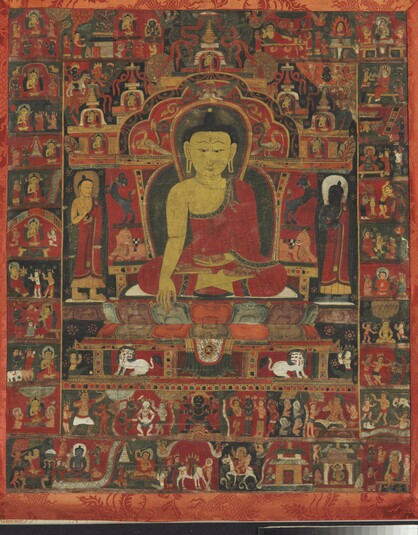
Item: Shakyamuni Buddha - Life Story (Single Composition)
| Origin Location | Nepal |
|---|---|
| Date Range | 1400 - 1499 |
| Lineages | Buddhist |
| Material | Ground Mineral Pigment on Cotton |
| Collection | Private |
Classification: Person
Appearance: Buddha
Gender: Male
Shakyamuni Buddha (Tibetan: sha kya thu pa, sang gye, English: the Enlightened One, Sage of the Shakya Clan): surrounded by vignettes portraying the 12 major deeds of his life.
Shakyamuni Buddha is a common subject in Tibetan art. He is depicted either as a single figure in a composition or together with the two principle disciples, Shariputra and Maudgalyayana. A slightly more elaborate painting might include the Sixteen Arhats, the Thirty-five Confession Buddhas and finally the Life story of the Buddha. Paintings such as these are very specific representations of the two Lower Vehicles of Buddhism according to the Tibetan Buddhist system. They depict the most important iconic figures and narratives that represent the Hinayana and Mahayana Traditions of Buddhism.
In Vajrayana Buddhism, more elaborate subject compositions will have Shakyamuni at the center surrounded by bodhisattva figures, worldly gods, meditational deities and protectors, leaving out the Two Disciples, Sixteen Arhats, Confession Buddhas and Life Story.
The particular type of composition represented here has Shakyamuni Buddha at the center accompanied by the two principal disciples and then the life story of Buddha in surrounding registers taking up nearly half the space of the total composition.
"Born in the Shakya race through skillful means and compassion, destroying the army of Mara who was unable to be destroyed by others, with a body radiant like a mountain of gold; homage to you, King of Shakya." (Tibetan liturgical verse).
Twelve Deeds:
1. The bodhisattva in the form of a white elephant leaving the Tushita heaven.
2. Entering the womb of queen Maya Devi.
3. The birth takes place in the Lumbini Grove.
4. Learning the worldly arts.
5. Observing birth, sickness, old age and death.
6. Leaving the palace and becoming a self-ordained monk.
7. Performing austerities.
8. Seated beneath the bodhi tree.
9. Defeat of the Four Maras.
10. Achieving Buddhahood.
11. Turning the Wheel of Dharma.
12. Passing into maha-pari-nirvana.
Jeff Watt 2-2014
Painting Style: West Tibet #2
Subject: Torana, Shakyamuni Buddha (Early Animal Depictions)
Shakyamuni Buddha: Early Paintings
Shakyamuni Buddha: Life-story (Single Composition)
Shakyamuni Buddha: Main Page
Shakyamuni Buddha: Life Story Main Page
Collection: Christie's. Jan. 28, 2014
Shakyamuni Buddha: Life-story (Register Composition)

